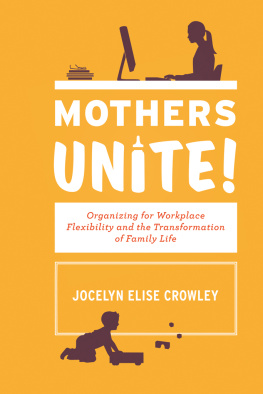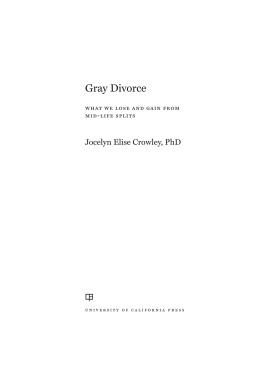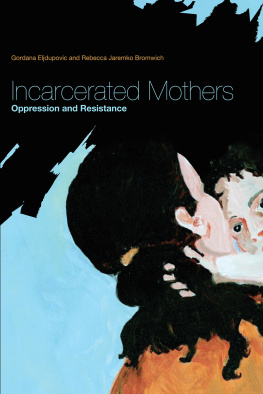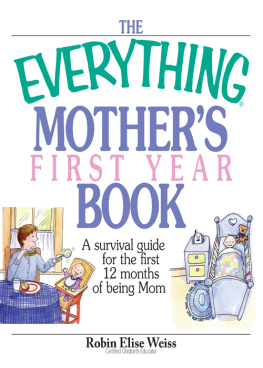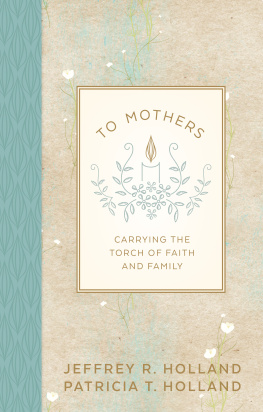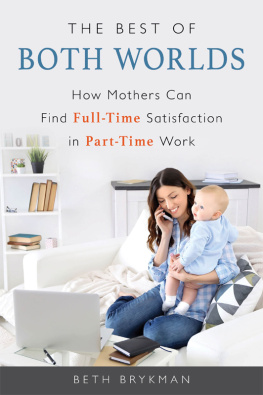Acknowledgments
I started thinking about writing this book when I was reflecting on a particularly vivid memory from my childhood. My mother was a single parent, working two jobs (including weekends), and going to school in the evenings. Money was very tight then, and I remember that she had no access to paid time off in case my sister or I became ill and had to be pulled out of elementary school. I did not want to put additional stress on my family, so I tried very hard not to get sick. In my childs mind, I feared that if my mother lost an afternoons wages picking me up from school, we might not have food on the table that night. That scare, that fright, has stayed with me until this day. This book aims to do something positive with those powerful, lingering emotions for all mothers and their children in the twenty-first century.
I thank the financial supporters of this project, without whom this book would have simply remained ideas loosely organized in my head. Thanks most of all to Kathleen Christensen at the Alfred P. Sloan Foundation for guiding the project to fruition. The Michael J. and Susan Angelides Public Policy Research Fund at the Edward J. Bloustein School of Planning and Public Policy at Rutgers was extremely generous in supporting the transcription of all the interview recordings included here. In addition, I benefitted from several Rutgers University Research Council grants, which helped with multiple parts of the project. Raymonde Pozzolano and her team offered excellent transcription services, as usual.
I am extremely grateful to the five mothers organizations that are the subject of this book. Their leadership were kind enough to provide me with access to their membership and trusted me to tell their stories accurately. The mothers who actually participated in the study, by being observed, interviewed, or surveyed, also gave generously of their time. I learned so much from them, and they have changed my perceptions about the challenges of motherhood forever.
I am also grateful to the staff at Cornell University Press. My editor, Frances Benson, believed in the project from the beginning and helped guide it seamlessly to publication. Kitty Liu answered all my annoying editing and production questions without complaint. Special thanks to Susan Specter and Romaine Perin for their excellent copyediting skills. Of course, the anonymous referees greatly enhanced the value of the work across each chapter.
Personally, I wrote this book during a time in my life that was incredibly challenging. It helped to remember that, as I heard the television character Dr. Gregory House advise, People get what they get. It has nothing to do with what they deserve. In addition to the help of a fictional protagonist, numerous real-life people supported me through this process. First of all, my colleagues at Rutgers went above and beyond the call of duty in helping me with this effortDr. Marc Weiner and Dr. Kelly Dittmar in particularI am looking at you! Liza Viana, Melissa Chedid, and Vanessa Alger also provided excellent research support. Second, my friends and close family built a firewall around me as I continued to write. Maryann Barakso, Elizabeth Wood, Theresa Luhm, Amy Schapiro, Sandhya Higgins, Ellen Braitman, John Spry, Michelle Wilson, Susan Crawford Sullivan, Suzanne Glaserthank you for listening. You constantly pointed to the light at the end of the tunnel that on many days I could not see. Most important, my mother, my sister Monica, and my husband did incredible amounts of hand-holding as I assembled the manuscript. I cannot thank them enough, and I dedicate this book to them. And, of course, M. B. Crowleys support never wavered. Dont worry, my precious angel, I will see you soon.
1
American Mothers, American Troubles
After graduating from Harvard Law School in 1988, a young woman named Michelle joined the law firm of Sidley Austin in Chicago, where she specialized in corporate transactions. The job offered more than an introduction to the complex world of legal analysis and maneuvering. When a handsome young summer associate came to work there, it took her only a little while to realize that she had met her romantic match .
With a partner whom she eventually married at her side, Michelle saw her career begin to rise as she moved on to challenging new opportunities. In 1991, after leaving Sidley, Michelle went to work for the Chicago mayors office; there she helped promote urban economic development in underserved neighborhoods. She then moved on to the Chicago Transit Authority to become head of the citizens advisory board. Later, she ran the nonprofit organization Public Allies, which trained young people for careers in public service by helping them secure internships. Following that experience, she went to the University of Chicago, taking a job in student services and initiating a new community-based program in order to enhance city-college interactions. By 2005, she had become vice president for community and external affairs at the University of Chicago Medical Center .
These career moves all ended in 2007, when the handsome young associate with whom she had fallen in love years ago at Sidley Austina man named Barack Obamadecided to run for president. With two young daughters, Malia, born in 1998, and Sasha, born in 2001, Michelle took a leave of absence from her job to help her husband campaign. When he became president, she permanently quit her paid job and declared her new employment intention to be mom in chief to her daughters .
Michelle Obamas story is, in many ways, a common one: that of the modern American middle-class mother. Each part of her tale resonates with some trace of who we were in the past and who we are now. That is, some of us can relate to the young woman, fresh out of school, trying to make a name for herself in the competitive professional world. Others are drawn to her quest to fulfill her true passions, whether they be in the corporate or nonprofit world. Still others focus on, ponder, celebrate, and critique her decision to devote herself to her family in recent years by dropping out of the paid labor force.
Perhaps, though, what is most compelling about Michelles story is that it is intriguing not only because of these distinct parts of her life but also because of the compelling push and pull of the forces that emerged over the complete trajectory of her evolution as a modern woman. She faced decisions that many middle-class mothers must confront as they experience the birth and then the numerous stages of their childrens development. When, exactly, should they have children? If they are working, how much time should they take off? Should they even return to the paid workforce at all? If they do return to work, who will take care of their children? Can they even afford not to work? What is the best arrangement for them, their families, and their children? How do they know that they have made the right decisions?
What is also compelling about Michelle Obamas life course is that it truly mixes the complex reality of personal and public decision making regarding if and how mothers pursue paid work in the United States. In this context, personal decision making means the range of individual choices mothers have within their reach about the future of their lives. Clearly, mothers make decisions about their educational and occupational pursuits all the time. With more resources at their disposal, such as a higher socioeconomic status and networking connections, many mothers have a broader array of choices that they can pursue. They can work in a demanding field, work part time, or not work for pay at all. They can purchase services that help them manage their lives, services such as high-quality child care and housekeeping assistance. Yet their stress levels may still behigh. Isolation, if they elect to stay at home, and feelings of being overwhelmed by paid work and family responsibilities, if they remain employed, are commonplace among this group of mothers.

